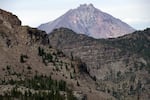
North Sister from Tam McArthur Rim near Bend, Ore., Oct. 9, 1994.
Tom Iraci / U.S. Forest Service
A new program launched this year to cut crowds at some of the most heavily trafficked trails in Oregon may have cut them a little too much.
When Central Cascades Wilderness Permits went on sale this past April, many of them were gone in a flash. And it turns out, most of the people who bought those permits never actually showed up.
Preliminary data from the U.S. Forest Service indicates about 52% of people who bought permits before the start of the season were no-shows, effectively barring would-be wilderness users from entry.
“Some people are arguing it’s great for the resource, but it really limited access to the wilderness,” said Jason Fisher, wilderness specialist for the Deschutes National Forest. “We’re not trying to block people out of these areas.”
Related: Permits may cut crowds and fuel demand in Central Oregon wildernesses
Overcrowding is a problem facing natural areas from national parks to humble community boat launches. The permit system in the Central Cascades is an ambitious attempt to reverse that trend at loved-to-death Oregon trails.
The system restricts the number of people allowed to enter the wilderness at 19 of the most popular trailheads in the Three Sisters, Mount Washington and Mount Jefferson wilderness areas on any given day.
“No one’s really undertaken this scope of a project,” Fisher said. “It’s a big bite, so to speak.”
Despite the no-shows, Fisher called the permit system’s inaugural year “pretty successful” overall. “You’re gonna see people, but you’re not in a conga line,” he said.
Several people told OPB they saw far fewer people on trails this year than in years past and that that was a good thing.
“[W]hen camping we got good sites and didn’t need to create new ones, and the overall experience of being in the wilderness was better not having a ton of people,” said Eric Holscher from Bend, in an email.
At the same time, Holscher and others also expressed concern about no-shows unfairly boxing people out of the wilderness.
People who bought permits before the start of the season were less likely to show than people who bought them as they came available throughout the summer. Still, 27% of people who made reservations during seven-day rolling windows were also no-shows, according to the Forest Service data.
The numbers won’t be final until after the permit season ends Friday, but Fisher said the Forest Service is already searching for ways to fix the no-show issue before next year.
Some hikers have suggested selling more permits to account for no-shows or creating more incentive for people to cancel reservations.
The Forest Service reported more than 57,000 people entered the wilderness with day-use permits this summer.
The agency issued more than 10,000 overnight permits for about 22,000 people. The average overnight group size was 3.8 people who stayed an average of 2.1 nights.
The Forest Service issued 13 violations, filed more than 330 incident reports and issued 315 verbal warnings — not all of which were related to permits.
